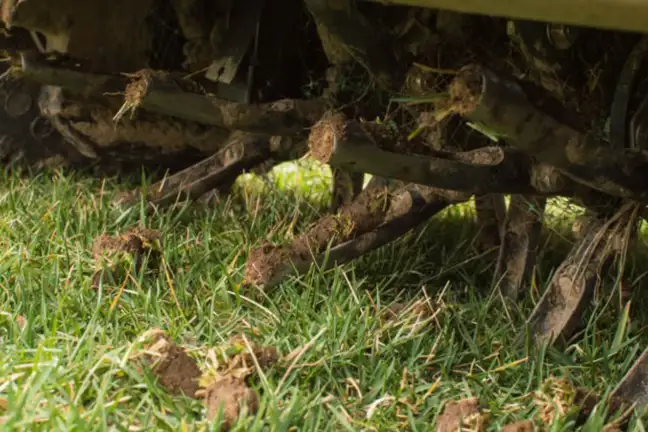How to Care for Your Lawn in Spring
Spring is a busy time for lawns and gardens! It's an opportunity to fix any problems with your lawn, so it's healthy, green and ready to enjoy during the warmer months.

Spring is a busy time for lawns and gardens! It's an opportunity to fix any problems with your lawn, so it's healthy, green and ready to enjoy during the warmer months.

Lawns can struggle through winter as slow (or no) growth means damage occurring from backyard games, pets and general wear and tear doesn't repair. So, spring is a great time to restore the lawn with a renovation.
Compacted soil limits the amount of nutrients and water that can penetrate the grass roots. By aerating an established lawn, it can loosen the soil and allow water, nutrients and air to be absorbed more deeply. This allows for deeper root development and a healthier more drought tolerant lawn. Aeration can be completed using a mechanical or inexpensive hand corer. Hand corers are great for small lightly compacted areas, but it is highly recommended to use mechanical methods for areas that are large or heavily compacted. Mechanical corers can be hired, or a contractor organised to do the job. Cores should be made every 2.5 X 5 cm.

Following an aeration, it is good to top dress the lawn to level out any low areas and then fertilise to encourage new blades of grass through the topdressing. Be sure to use a fine material for topdressing to ensure it filters through as the leaf blades grow.

Spring is a great time to fix damaged lawns, because new grass seedlings will have time to establish before the hot weather arrives.
Before sowing lawn seeds, remove any weeds and dead grass and loosen the soil. Apply a lawn starter fertiliser such as Yates Dynamic Lifter Lawn Food then scatter Yates Lawn Seed Repair. This premium blend of grasses has a built-in slow-release lawn fertiliser specially formulated to repair bare or patchy lawn areas.
Water thoroughly and regularly for several weeks until the new grass is established. It's very important to ensure the soil surface doesn't dry out during that time.
It's ideal to control many broadleaf weeds, like bindii, clover and dandelions, during winter, before they have a chance to flower, set seed and spread. However, there are many additional broadleaf weeds that flourish in spring, such as thistles, plantain and capeweed, and it's important to get them under control to keep your lawn looking great.
There are easy options for controlling the most common broadleaf weeds in lawns, including hose-on Yates Weed'n'Feed and Click & Grow Yates Weed'n'Feed. These both have the added benefit of providing nutrients to green the lawn.
For buffalo lawns, use Yates Weed'n'Feed Buffalo Lawn or Yates Lawn Weed Killer Bindii & Clover Buffalo Lawn, which have been specially designed to be safe for buffalo lawns.

Grass needs nutrients during late winter and spring to help break it out of dormancy, begin the growing season and promote green healthy growth. Yates Dynamic Lifter Lawn Food is ideal to feed and green all lawn types as well as promote healthy soil. Spread the granules evenly over the lawn or use the pouch with the Click & Grow Trigger.
Curl Grubs are common lawn pests that often arrive during mid-spring and summer. They damage the lawn by eating the roots just below the soil surface. This creates brown patches and eventually grass can start rolling back like a carpet. Monitor your lawn for curl grubs and take note if large birds such as magpies are pecking at the ground. Yates Grub Kill & Protect for Lawns can give up to six months protection against Curl Grubs, as well as control other common lawn pests such as Argentinian Scarab larvae and Lawn Armyworm. Curl Grubs are the larvae of African Black Beetles, however, if you notice the adult beetles, you will need to use Yates Advanced Lawn Insect Killer to control them.

For the first mow of the spring, make sure your mower has sharp blades, to give your turf an even, crisp cut. If your lawn has grown long over the winter, don't cut it extra short just because it's spring; this can damage the grass and make it turn brown and patchy. Wait until the soil has warmed up and grass is noticeably growing before you cut it. For the first cut, don't cut more than a third off its length. For cool season grasses such as Bent and Fine Fescue, aim for around 2-3 cm, and for warm season grasses such as Couch, Kikuyu and Buffalo, cut to around 4 cm.

Particularly if it's been a dry winter, it's important to give your lawn 2 - 3 thorough waterings each week to enable moisture to move down deep into the soil. This will help keep the lawn looking great in spring and also promote deep growth that will assist the lawn to cope with the heat of summer.
To ensure water penetrates into the soil effectively, use a soil wetting agent such as Yates Waterwise Soil Wetter. This will help break down the waxy, water-repellent soil layer and make the most of any rainfall or watering.
